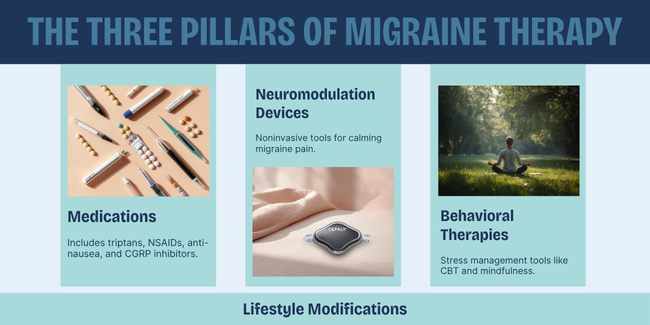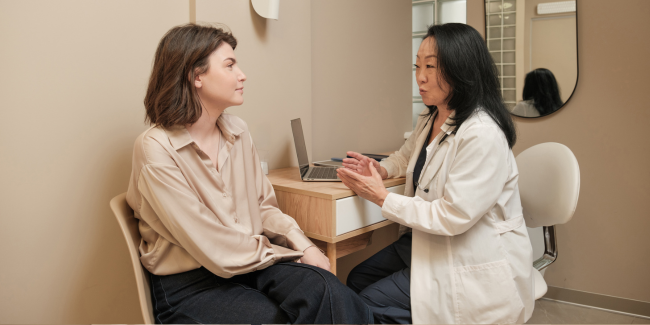If you’ve ever felt like one migraine medication just isn’t enough, you’re not alone.
Migraine is a complex neurological condition influenced by genetics, hormones, environment, and lifestyle—and because of that, no single treatment works for everyone.
That’s why specialists today often recommend combination treatments—personalized plans that blend two or more therapies to tackle migraines from multiple angles and deliver better results.
What Is a Combination Treatment for Migraine?
In simple terms, a combination treatment means using two or more migraine therapies at the same time that work in different ways.
There are a few main types:
-
Combination acute treatment – Using two medications during an attack, such as a triptan and an anti-inflammatory like naproxen, for stronger and faster relief.
-
Combination preventive treatment – Taking two different long-term treatments, such as Botox injections plus a CGRP inhibitor, to reduce the frequency and intensity of attacks.
-
Multimodal treatment – Combining medications with other therapies like nerve blocks, neuromodulation devices, or behavioral therapy for a more comprehensive plan.
This is different from a single pill that contains multiple drugs (a fixed combination). Combination treatment means layering separate therapies—each customized to your needs and adjusted over time.

The Three Pillars of Migraine Therapy
Effective migraine management relies on a well-rounded treatment approach. Most migraine specialists focus on three main pillars of therapy designed to reduce frequency, ease symptoms, and improve overall quality of life.
-
Medications
These include oral or injectable options such as triptans, NSAIDs, anti-nausea medications, and CGRP inhibitors that help prevent or relieve migraines. -
Neuromodulation Devices
Noninvasive devices that use gentle electrical or magnetic stimulation to calm overactive nerves involved in migraine pain. -
Behavioral Therapies
Stress-management tools such as cognitive behavioral therapy (CBT), progressive muscle relaxation, and mindfulness.
All of these are supported by lifestyle modifications—consistent sleep, hydration, nutrition, exercise, and tracking your triggers with a migraine diary.
Why One Treatment May Not Be Enough
Migraines affect multiple systems in the body, so targeting just one mechanism may not provide complete relief.
Combination treatments can offer:
-
Better control of migraine frequency and severity
-
Lower doses of each medication, minimizing side effects
-
Improved overall quality of life with fewer breakthrough attacks
For instance, pairing sumatriptan and naproxen has been shown to improve pain outcomes compared to either drug alone. Similarly, combining Botox with CGRP inhibitors or adding behavioral therapy to preventive medication can lead to stronger, longer-lasting results.

A Step-by-Step, Personalized Approach
At the Migraine Relief Center in Houston, combination therapy is never one-size-fits-all.
Our specialists build your plan step by step:
-
Start with a baseline treatment – A preventive medication, injection, or device.
-
Monitor and optimize – We assess your progress, side effects, and lifestyle factors.
-
Add another therapy if needed – Layering complementary treatments for stronger, safer results.
-
Evaluate and adjust regularly – We fine-tune your plan to maximize relief and minimize risks.
This thoughtful, data-driven process mirrors how other chronic conditions are managed—using multiple therapies to reach better long-term control.
When to Ask About Combination Treatment
If you’re still having frequent or severe migraines despite treatment, ask your specialist whether a combination approach could help.
Questions to bring to your appointment include:
-
What treatments can be safely combined with what I’m currently using?
-
How will we measure progress and adjust as needed?
-
Are there lifestyle or behavioral options that could enhance my results?
The Bottom Line
Migraines are complex, but your treatment doesn’t have to be. By combining therapies that target different aspects of migraine, you can achieve more complete relief and reclaim your quality of life.
At the Migraine Relief Center, we specialize in personalized, multimodal migraine management—helping patients find lasting relief through thoughtful, evidence-based combination treatments.
If you’ve been struggling to find the right solution, schedule an evaluation today to explore a combination plan designed just for you.

